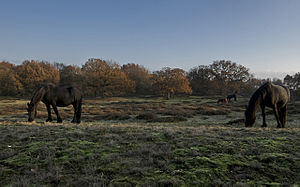Herding
![]()
The title of this article is ambiguous. For the district of the market town Thurnau see Hutweide (Thurnau).
The term Hutweide (also Hutung or Magerweide), which was often used in the past, refers to a larger agricultural area onto which domestic animals are or were driven to graze under the supervision of a shepherd or older child.
The name is hardly used today in some regions, but lives on as a term of land use (among other things in surveying as a defined cultural genre) as well as in countless field names. Examples of the latter are Hutweide, Hiataweid', Hutleiten, Hutwald, Hutgraben. When regulated livestock farming became established in Europe, the Hutweide served not only to forage (pasture, ground crops) for the sheep, horses, cattle or goats, but also to fertilise the soil and slowly thin out overly dense forests.
The latter aspect - as a so-called herding forest - was partly also the preparation of later cultivation of forest areas. For a copse searched for grasses and fruits by the grazing cattle developed into a sparser forest with little undergrowth and better growing conditions for grasses and partly also herbaceous plants.
Later, the pastures were demarcated in order to secure grazing rights or to reduce the need for personnel. Today, hat grazing is experiencing a regional renaissance, on the one hand on alpine pastures (mountain pastures), on the other hand for nature conservation purposes (preservation of rural areas) and through the revival of itinerant herders. Technically, hat grazing is facilitated by traditional flexible grazing fences (bark hunter's fence, etc.) and, in recent decades, by electric fences, which today are mostly strung with cable reels and field-ready batteries (i.e. without mains connection).

Witnesses of the Hude: Horses graze for biotope maintenance on the former hat pasture of Borken in Emsland
See also
- Hute Forest
- Hutanger
- Pasture (grassland)
- Alm (mountain pasture)
Questions and Answers
Q: What is herding?
A: Herding is the action of gathering individual animals together into a collective group or herd and moving them from one place to another.
Q: How did herding originate?
A: Herding became a way of life for many nomadic people thousands of years ago.
Q: Who practices herding today?
A: Herding is still vital for farmers, ranchers, and people who raise domestic animals.
Q: What is the goal of herding?
A: The goal of herding is to maintain a group of animals and transport them between locations.
Q: Why is herding important for farmers and ranchers?
A: Herding is essential for farmers and ranchers as it enables them to control their animals and ensure their safety while transporting them from one site to another.
Q: Can anyone perform herding?
A: No, not everyone can do herding as it requires proper training, animal handling knowledge as well as specialized tools and equipment.
Q: How has herding changed over time?
A: While herding techniques have evolved over time, the basic principles remain the same, that is to say, to move animals from one location to another while keeping them safe and maintaining the group.
Search within the encyclopedia